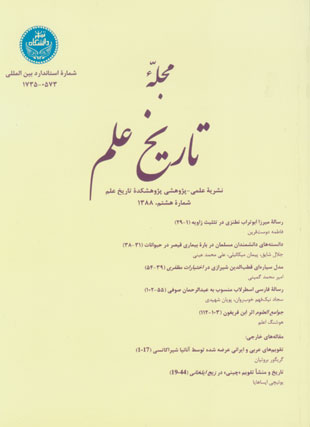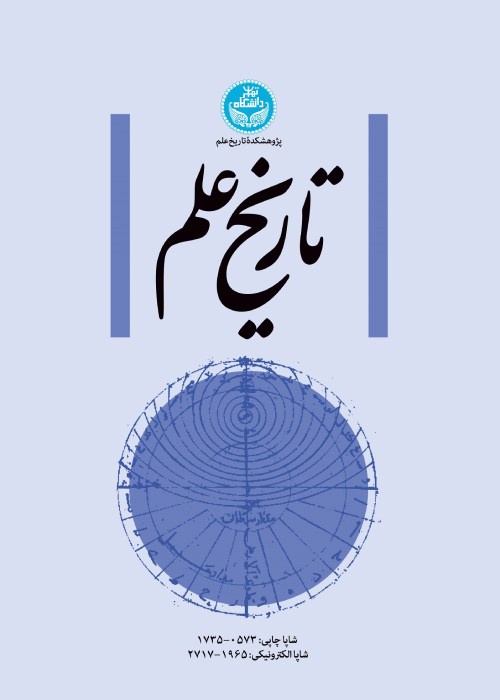فهرست مطالب

مجله تاریخ علم
سال هفتم شماره 1 (پیاپی 8، بهار و تابستان 1388)
- 204 صفحه، بهای روی جلد: 20,000ريال
- تاریخ انتشار: 1388/03/13
- تعداد عناوین: 12
-
-
صفحه 1تثلیث زاویه به همراه تربیع دایره و تضعیف مکعب از مسائل کهن ریاضی است که ریاضی دانان بسیاری درباره آنها اظهارنظر کرده اند. محاسبه وتر ثلث یک زاویه با استفاده از یک معادله جبری از جمله روش هایی است که برای حل مساله تثلیث زاویه عرضه شده است. غیاث الدین جمشید کاشانی (د. 832ق) در رساله الوتر و الجیب خود با به کارگیری این روش جیب زاویه یک درجه را با داشتن جیب زاویه سه درجه محاسبه کرد. پس از او دیگر ریاضی دانان مانند قاضی زاده رومی (د. حدود 840ق) رساله هایی بر مبنای این رساله کاشانی تالیف کردند. میرزا ابوتراب نطنزی (د. 1262ق) ریاضی دان عصر قاجار نیز، در اثرش به نام رساله در معرفت وتر ثلث قوس معلومه الوتر به این مساله پرداخته است. روش او اساسا هندسی است و از لحاظ ریاضی با روش جبری جمشید کاشانی هم ارز است. در این مقاله با ذکر پیشینه ای از مساله تثلیث، این رساله بررسی خواهد شد.
کلیدواژگان: تثلیث زاویه، جیب یک درجه، میرزاابوتراب، دوره قاجار -
صفحه 31در متن های دامپزشکی دوره اسلامی بارها به نام قیصر در زمره بیماری های دامی برمی خوریم که به ویژه در اسب به خوبی توصیف شده است. اشاره به انقباضات عضلانی، بیرون زدگی پلک سوم، اختلال در بلع و علایم دیگر از موارد مهم مورد اشاره در متن های مذکور هستند که این احتمال مترادف بودن واژه قیصر با کزاز دامی و به ویژه اسبی را قوت می بخشد. در این مقاله به بررسی دو مفهوم کزاز و مترادف های قیصر از دو دیدگاه ریشه شناسی و مفهوم شناسی تاریخی و همچنین بررسی علمی آسیب شناختی بیماری قیصر پرداخته ایم.
کلیدواژگان: قیصر، کزاز، دامپزشکی -
صفحه 39قطب الدین شیرازی از منجمان صاحب نظریه در حوزه مدل های غیر بطلمیوسی است. بعد از آن که مدل سیاره ای قطب الدین برای سیارات خارجی، با مطالعاتیدردو کتابنهایه الإدراک فی درایه الافلاک و التحفه الشاهیه معرفی شد، مورخان علم متوجه شدند که این مدل در واقع از آن منجم دیگر مکتب مراغه، مؤیدالدین عرضی، است. بنابر این، مدل سیاره ای قطب الدین برای سیارات خارجی تا به امروز ناشناخته مانده بود. مدل سیاره ای قطب الدین برای سیارات خارجی،در کتاب اختیارات مظفری با وضوح بیشتری عرضه شده، که در این مقاله معرفی می شود. البته این مدل بر خلاف دیگر مدل های غیربطلمیوسی مکتب مراغه، دارای اشکالات رصدی است، چرا که در این مدل، مرکز تدویر در فاصله نسبتا زیادی از مرکز تدویر بطلمیوس در نظر گرفته می شودو در نتیجه فاصله مشاهدات رصدی و مقادیر محاسبه شدهقابل چشم پوشی نیست.
کلیدواژگان: مدل سیاره ای غیر بطلمیوسی، اختیارات مظفری، قطب الدین شیرازی -
صفحه 55عبدالرحمان صوفی منجم شناخته شده ای است که آثاری در زمینه نجوم، ریاضیات و کیمیا دارد. اهمیت کتاب صورالکواکب اش سبب شده است که به دیگر آثار او کمتر پرداخته شود. چهار رساله در اسطرلاب به صوفی منسوب است که یکی از آنها به فارسی است. از میان این چهار رساله انتساب سه رساله عربی به او قطعی است. در این مقاله ضمن ویرایش متن رساله فارسی، مطالب آن با معادل هایش در رساله های عربی مقایسه شده است.
کلیدواژگان: عبدالرحمان صوفی، اسطرلاب -
صفحه 103نوشته منتشر نشده ای که از مرحوم هوشنگ اعلم به زبان فرانسه بر جای مانده و خانم نگار نادری آن را به فارسی برگردانده است. تصویر دست نوشته به جا مانده از هوشنگ اعلم در پایان این مقاله پیوست شده است.
-
صفحه 113
-
صفحه 144
-
صفحه 149
- مقاله های خارجی
-
صفحه 1در این مقاله برآنیم تا تقویم های ایرانی و عربی را که آنانیا شیراکاتسی، دانشمند سده هفتم میلادی ارمنستان، در آثار خود آورده است، بررسی کنیم. تقویم های مسیحیان عرب و ایرانی که در کارهای آنانیا به آنها اشاره شده است بر اساس تقویم یولیانی، 365 روز و ربع روز به ازای هر سال هستند. او با استفاده از تقویم های ایرانی و عربی، تغییراتی را که مسیحیان ساکن در سرزمین های ایرانی وعربی در تقویم یولیانی داده بودند بیان کرده است. این تقویم ها با آنچه معمولا به عنوان تقویم عربی (اسلامی) یا ایرانی شناخته می شوند، بسیار متفاوتند.
-
صفحه 19این مقاله به «تقویم چینی» که در زیج ایلخانیاز آن یاد شده است، خواهد پرداخت. در تحقیق های پیشین برخی مشخصه های این تقویم به «اویغورها» نسبت داده شده و در اینجا من نشان می دهم که این تقویم ربطی به اویغورها ندارد. این تقویم چینی را یک تائویست به نام فو منگشی که به همراه هولاکو به ایران رفته بود، و نصیرالدین طوسی در زیج ایلخانی از او یاد کرده، به ایران برده است. بعدا هم به عنوان تنها تقویم مورد استفاده مغول ها و اویغورها، در زیج محی الدین مغربی آمده است. محی الدین مغربی عنوان «تقویم چینی» را به «تقویم چینی- اویغور» مبدل کرد و این در زیج های بعدی نیز تکرار شد، از این رو محققان امروز آن را تقویم اویغوری می نامند. هر چند اطلاق عنوان اویغوری برای این تقویم در آثار بعدی، مشخصه های اصلی آن را تغییر نداد اما تغییراتی در کاربرد آن به وجود آورد.
-
صفحه 45
-
صفحه 50
-
Page 1Trisection of an angle is one of the famous problems in the history of mathematics. The impossibility of trisecting an angle with a straightedge andcompasses was known. Therefore finding an accurate approximation of irrational quantity of the Sine of degree- which was important for setting up sine tables in Zījes, and also for astronomical calculations- is very difficult. So, many scientists devoted their attempts to find a solution to this problem. MīrzāAbūTorābNatanzī, a scholar of theQajarid era, in a Persian treatise entitled Darma‘rifat-i watar-i thulth-i qaws-i ma‘lūmat al-watar (on the knowledge of the chord of one-third of an arc with a known chord), presented a geometrical method for trisecting an angle which turns out to be mathematically equivalent to the algebraic method of JamshīdKāshānī (al-Kāshī) for finding the Sine of one degree. Surveying different approximate methods of trisecting an angle in ancient Greek and Islamic periods, this paper presents a critical edition and a commentary of MīrzāAbūTorāb’s treatise.
-
Page 31In the veterinary texts of the Islamic period, we frequently encounter the word Qeysar, which is an animal disease and specially has been well described in horses. It is characterized by muscular contractions, the retraction of the third eyelid, dysphasia and other symptoms that have been mentioned in the veterinary literature of Islamic period manuscripts. Considering these symptoms and some evident similarities, we have tried in this study to compare Qeysar with Tetanus. Our methods are etymological and historical studies of these three words (Qeysar, Kozāz and Tetanus), in classical Arabic, Persian and also western (Roman and Greek) sources. According our knowledge, this is the first scientific study of Qeysar in the view point of pathology and etimology of this disease.
-
Page 39The main problem of Ptolemaic model of the superior planets was related to the“equant point”. It is a geometrical point with respect to which the motion of the deferent sphere is uniform. But it cannot be acceptable on the basis of Aristotle's philosophy on the motions of celestial spheres. Astronomers of Maragha School devised some new models to avoid this problem, while they were in accordance with Ptolemy's observations. Qutb al-DīnShīrāzī(d. 1311) has provided his own model for superior planets in his works: Nihāyat al-idrākfīdirāyat al-aflāk andal-Tuhfa al-Shāhīyya in Arabic, and Ikhtiārāt-i Muzaffarī in Persian. His model in Ikhtiārāt has not been studied yet and it is different from the one introduced bySaliba (1979) and Kennedy (1966). Here, I introduce Qutb al-Dīn's model for superior planets provided in eighth chapter of the second book of Ikhtiārāt-i Muzaffarī.I also discuss a conflict between observations and the theory which this model involves.
-
Page 55‘Abdal-Rahmānal-Sūfī is a well-known astronomer who has some works in astronomy, mathematics and alchemy. The importance of his Suwar al-Kawākib (book about the constellations) caused that researchers don’t practice his other works. Four treatises on astrolabe are ascribed to al-Sūfī, any one of them is in Persian. Attribution of the three Arabic treatises among these four to him is certain. In this article, besides providing a critical edition of the Persian text, its contents are compared with the Arabic versions.
-
Page 103This is an unpublished work by the late Dr. HooshangA‘lam on IbnFarīghūn’sDjawāmi‘ al-‘ulūm. The work has been written in French and translated into Persian by Mrs. NegarNaderi. The scan copy of Dr. A’lam’s handwriting is provided at the end of the article.
-
Page 1Here is an attempt to present the ideas concerning the Medieval Persian and Arabic calendars as offered in the works of the 7th century A.D. Armenian scientist AnaniaShirakatsi. The calendars of Christian Persians and Arabs, as explained in Anania’s work, are of the Julian type, with 365.25 days per year. By Persian and Arabic Calendars, he means variants of the Julian calendar used by groups of Christians living in the Persian and Arabic lands. These calendars had a structure very different from what is generally known as Arabic or Islamic and the traditional Persian calendar.
-
Page 19This article sheds light upon a “Chinese” calendar described in the Zīj-i Īlkhānī. In previous studies, some characteristics of the calendar were ascribed to the “Uighurs” However, I will show that it was not originally associated with the Uighur. This “Chinese” calendar was brought to Iran by the Chinese Taoist Fu Mengchi who accompanied his ruler Hülegü. Fu Mengchi informed Nasīr al-DīnTūsī of the Chinese calendrical system, which Tūsī described in his Zīj-i Īlkhānī. Soon afterward, the calendar was included in the zīj of Muhyī al-DīnMaghribī, because it was only used among the Mongol ruling class and their Buddhist servants, who were called Uighur. Muhyī al-Dīn labeled the “Chinese” calendar the “Chinese-Uighur” calendar, and this title was repeated in subsequent zījes. Therefore, modern scholars have regarded the calendar as a product of the Uighurs. However, the title “Uighur” attached to the calendar in later zījes does not reflect the characteristics of the calendar, but rather the circumstances in which it was utilized.


